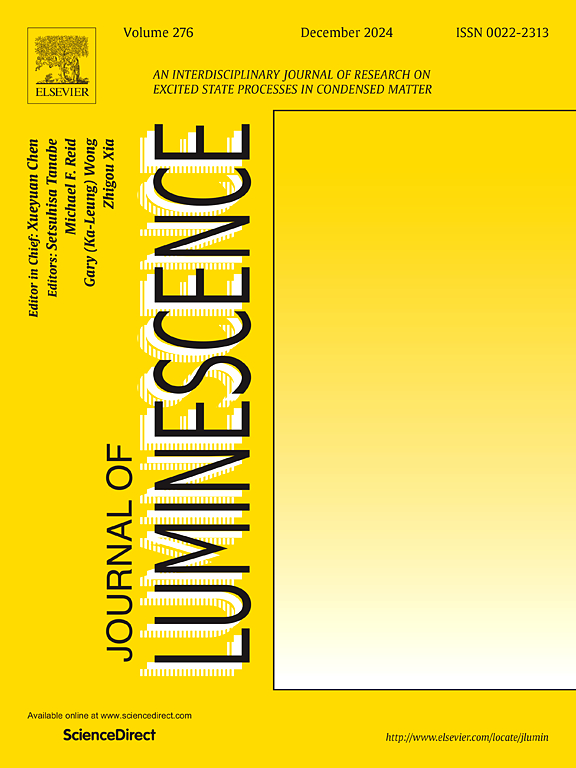高性能钙钛矿发光二极管后处理阴离子交换工艺研究进展与挑战
IF 3.3
3区 物理与天体物理
Q2 OPTICS
引用次数: 0
摘要
钙钛矿发光二极管(PeLEDs)由于其易于溶液处理,高发光效率和卓越的颜色纯度,正在迅速发展为下一代显示技术。尽管在近红外、红色和绿色pled方面取得了重大进展,但由于卤化物偏析、无机氯化物的溶解度差以及光致发光量子产率低,深蓝pled的性能明显落后。为了解决这些挑战,后处理阴离子交换(PTAE)方法已经成为开发高性能深蓝ped的一种新方法。这项工作的重点是ptae处理的ped的最新进展,突出了Cl−离子产生的不同策略。分析了阳离子尺寸对薄膜形貌、光电性能及卤化物交换动力学的影响。这篇综述强调了PTAE方法在产生多色显示技术所必需的明亮和稳定的红、绿、蓝发射中的应用。探讨了彻底改进PTAE技术和促进对卤化物交换机理的认识的重要性。该综述还概述了主要挑战,并提出了未来的研究方向,以解决这些挑战。总的来说,这项工作的目的是作为一个有价值的资源,并激励研究人员在凝聚态物理,材料科学和固态化学。本文章由计算机程序翻译,如有差异,请以英文原文为准。
Advancements and challenges in post-treatment anion exchange process for high-performance perovskite light-emitting diodes
Perovskite light-emitting diodes (PeLEDs) are rapidly evolving for next-generation display technologies, owing to their facile solution-processing, high luminous efficiency and exceptional color purity. Although significant progress has been achieved in near-infrared, red, and green PeLEDs, however, the performance of deep-blue PeLEDs lags significantly behind due to halide segregation, poor solubility of inorganic chlorides, and low photoluminescence quantum yields. To address these challenges, the Post-Treatment Anion Exchange (PTAE) method has emerged as a novel approach for developing high-performance deep-blue PeLEDs. This work focuses on recent advancements in PTAE-treated PeLEDs, highlighting different strategies for the generation of Cl− ions. The impacts of cation size on film morphology and optoelectronic properties and the underlying halide exchange kinetics are analyzed. This review highlights the application of the PTAE method for producing bright and stable red, green, and blue emissions essential to multi-color display technologies. It investigates the importance of thorough improvement of the PTAE technique and advancing the understanding of the halide exchange mechanism. The review also outlines key challenges and proposes future research directions to tackle with them. Overall, this work aims to serve as a valuable resource and to inspire researchers in condensed matter physics, materials science, and solid-state chemistry.
求助全文
通过发布文献求助,成功后即可免费获取论文全文。
去求助
来源期刊

Journal of Luminescence
物理-光学
CiteScore
6.70
自引率
13.90%
发文量
850
审稿时长
3.8 months
期刊介绍:
The purpose of the Journal of Luminescence is to provide a means of communication between scientists in different disciplines who share a common interest in the electronic excited states of molecular, ionic and covalent systems, whether crystalline, amorphous, or liquid.
We invite original papers and reviews on such subjects as: exciton and polariton dynamics, dynamics of localized excited states, energy and charge transport in ordered and disordered systems, radiative and non-radiative recombination, relaxation processes, vibronic interactions in electronic excited states, photochemistry in condensed systems, excited state resonance, double resonance, spin dynamics, selective excitation spectroscopy, hole burning, coherent processes in excited states, (e.g. coherent optical transients, photon echoes, transient gratings), multiphoton processes, optical bistability, photochromism, and new techniques for the study of excited states. This list is not intended to be exhaustive. Papers in the traditional areas of optical spectroscopy (absorption, MCD, luminescence, Raman scattering) are welcome. Papers on applications (phosphors, scintillators, electro- and cathodo-luminescence, radiography, bioimaging, solar energy, energy conversion, etc.) are also welcome if they present results of scientific, rather than only technological interest. However, papers containing purely theoretical results, not related to phenomena in the excited states, as well as papers using luminescence spectroscopy to perform routine analytical chemistry or biochemistry procedures, are outside the scope of the journal. Some exceptions will be possible at the discretion of the editors.
 求助内容:
求助内容: 应助结果提醒方式:
应助结果提醒方式:


